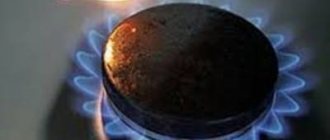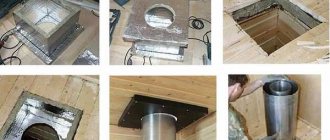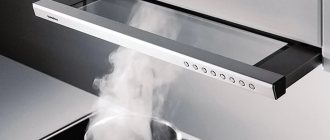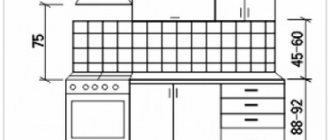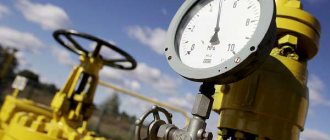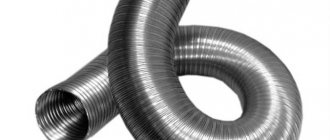When arranging the gas supply for your home or apartment, you need to think through a huge number of things, in particular, the distance from the outlet to the gas pipe, regardless of when the electrical wiring was installed or reconstructed, before or after the development of the project.
The next crazy requirements, recommendations to complicate the process, or reasonable standards? What happens if you don’t follow the rules and put wires anywhere?
We will answer these and many other questions about the combination of electricity and gas supply in one room in detail.
Connecting a gas boiler to the chimney
The diameter of the chimney must be equal to or greater than the diameter of the outlet pipe in the device.
In most cases, the diameter of the chimney depends on the power:
- 100 kW - 230 mm;
- 80 kW - 220 mm;
- 60 kW - 190 mm;
- 40 kW - 170 mm;
- 30 kW - 130 mm;
- 24 kW - 120 mm.
Ordinary chimneys go up, 0.5 m above the ridge of the house. They are installed both inside the wall of the house, and inside the house or behind its wall. No more than 3 bends are allowed on the pipe. The first section of the pipe, which connects the boiler to the main chimney, must be no more than 25 cm. The pipe must have a closable hole for cleaning. Boilers with ordinary chimneys and an open combustion chamber require a large air flow. It can be provided either with an open window or with a separate supply pipe.
The chimney must be made of roofing sheet or other material that is resistant to acids. Do not connect the boiler with corrugation to the main chimney. A brick chimney cannot be used either.
The coaxial chimney must be mounted horizontally and discharged into the wall. This type of chimney is a pipe within a pipe. It should extend from the wall at least 0.5 m. If the boiler is ordinary, then the chimney pipe should have a slight slope towards the street. If the device is condensing, then the tilt should be towards the device itself. This way, the condensate will be able to drain into a special pipe, which will need to be diverted to the sewer. The maximum length of coaxial chimneys is 5 m.
What are the norms regulated by?
The distance from the outlet to the pipeline, from electrical cables to gas pipes is regulated by a group of regulatory legal acts of the Ministry of Energy - PUE - rules for the construction of electrical installations.
They clearly describe the requirements for heating systems, gas pipelines, and their location in relation to electrical communications. All parameters for the location of electrical appliances, wires, sockets in relation to gas and heating pipes must be indicated in the room design. They must be prescribed when drawing up a layout of a kitchen or other room. Control over compliance rests with gas office workers. They record the violation and give instructions to eliminate the deficiencies.
But in any case, each of us must understand that the safety of housing, the health and life of its inhabitants, and the safe operation of equipment for a long time depend on the proper placement of all communications in the apartment.
source
How to avoid problems?
First of all, following the rules is your health and safety for your life.
Therefore, if you combine gas and electric, use a few simple recommendations:
- Follow the rules of the PUE and SP exactly.
- At the entrance to your apartment, install a protective shutdown device that guarantees a power outage in case of problems with the neutral wire.
- Before installing the wiring, make sure that the new one will match the wiring of the old circuit (if it does not change).
- A gas stove cannot be grounded through a gas pipeline, just like ordinary household items that run on electricity.
And in addition, be sure to use the services of experienced electricians and enter into contracts when installing electrics for gas appliances.
Always check the license and documents of the gas workers whom you call to install gas-using equipment. In addition, be sure to conclude a bilateral agreement and check that the electrical installation of the devices is carried out in accordance with all the rules
All these recommendations will help you avoid problems with regulatory authorities and ensure a safe energy supply.
Piping a gas boiler in the heating system
After the wall-mounted gas boiler has been installed and the heating device is placed on the wall, the first thing you need to do is connect it to the heating system. Depending on which model is installed, single-circuit or double-circuit, there are different piping schemes. We will look at the connection process using the example of a wall-mounted double-circuit gas boiler.
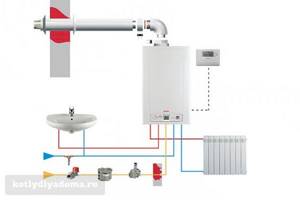
As you know, a double-circuit boiler, in addition to heating, is capable of producing hot water for household needs. Structurally, this is realized by installing one bithermal or two separate heat exchangers. A double-circuit boiler does not produce very much hot water, but it is quite enough for 1-2 distribution points (for example, a kitchen faucet and shower).
A modern wall-mounted gas boiler is very compact and already contains within itself the basic elements necessary for the operation of a heating system with forced circulation, such as: a circulation pump, an expansion tank, a safety group. In the heating systems of small private country houses, this is more than enough, but if necessary, you can install an additional expansion tank or another pump.
At the bottom of any mounted double-circuit boiler there are 5 pipes. They are connected to: supply and return lines of the heating system, supply and return of hot water supply, main gas. The gas connection is usually located in the center and is colored yellow. All other lines can be located in any order, depending on the model of the gas boiler. Therefore, before starting tying, it is necessary to clarify the purpose of each of them in the operating instructions.

The piping of a wall-mounted gas boiler is done with polypropylene or metal pipes. The cross-section of heating pipes is usually larger than DHW pipes 3/4 and 1/2 inches, respectively. The heating system is connected to the boiler through American nuts. Ball valves are installed on each line for the convenience of dismantling the gas boiler without draining the coolant and to isolate the boiler from the heating system if necessary. To ensure tightness, all connections must be made using plumbing FUM tape or flax.
Coarse filters must be installed in the heating return line and in the DHW supply line. For ease of washing and cleaning, they are also cut off by shut-off valves. Often, in order to increase the service life of the secondary heat exchanger of a double-circuit boiler, a magnetic fine filter is additionally installed at the DHW supply.
Distance from the house to the object outside the fence
When deciding on the placement of a house on a site, they also take into account the distance of the future building to power lines, gas pipelines, railways and cemeteries. This will protect households from traffic noise and fumes from burial sites, and avoid flooding and subsidence of a private building located on excessively wet soil.
Before power lines
To protect the population from electric shock due to accidental deformation of wires, security zones are established on both sides of power lines. Within these areas, housing construction and the construction of dacha and gardening partnerships are prohibited. If a house does end up within the power line, it is not demolished, but a ban on reconstruction and capital construction is imposed.
The minimum distance from the house to the power line depends on its voltage
Compliance with power line security zones also ensures the safety of the electrical network section from fluctuations that occur during the construction of a house. The safe distance from the fence to power lines is determined based on the voltage level and is:
- 35 kV – 15 m;
- 110 kV – 20 m;
- 220 kV – 25 m;
- 500 kV – 30 m;
- 750 kV – 40 m;
- 1150 kV – 55 m.
To the pond
When dreaming of a house near a river or pond, you need to determine whether the purchased plot is included in a water protection zone - land adjacent to a water body with special legal protection. The establishment of a special regime is aimed at preventing pollution, siltation and salinization of the soil, preserving the richness of waters and maintaining the natural biocenosis.
The minimum distance from the house to the river depends on the type of reservoir
Building a house near a pond also carries the risk of its destruction due to its placement on softened soil. When laying the foundation, the width of the water protection zone of a river or sea is taken into account. This territory is determined by the length of the reservoir and is:
- 10 km – 50 m;
- up to 50 km – 100 m;
- over 50 km – 200 m;
- for the sea - more than 500 m.
To the gas pipe
If there is an external gas pipeline on the site, the distance between it and the house must be at least 2 m. The safety distance for underground pipes is determined based on the gas supply pressure. Within populated areas, as a rule, the pressure in the gas pipeline does not exceed 0.005 MPa. In this case, the foundation is laid at a distance no closer than 2 m from the gas pipe.
In the village, a distance of 2 m is sufficient to the low-pressure gas pipe
To the road
In different settlements, the distance between the fence and the road varies. In small villages, as a rule, this figure should be at least 3 m. If the local administration has allowed to deviate from the standards, it is still better to build a fence away from the passage. This will not only protect residents, but also make it easier to access the site.
It is better to stay away from the dust and smells of the road: at least five meters from the fence
When talking about the distance between the fence and the road, the concepts of “road” and “roadway” are distinguished. The first is called a roadbed with a pedestrian zone and a roadside, the optimal distance to which is about 3 m. The second is considered an area for the movement of vehicles. If the land plot is located near highways, the distance to the fence should be at least 5 m.
To the cemetery
The norm for the distance from a cemetery with an area of more than 20 hectares to a residential building is at least 500 m. If the site is located in a village near a small cemetery, the dwelling should be located at least 300 m away from it. For columbariums, memorial complexes, closed burial places, the permissible the distance to the home is 50 m.
The minimum distance to the cemetery is determined by its size
To the railway
The noise and smell from the railway will not please anyone: we are building a house no closer than 100 m
To protect land owners from train noise, the distance from the private sector to the railway must exceed 100 m. If the railway track is located in a depression, or the carrier company has taken measures to ensure noise protection (installed noise barriers, fences), it is permissible to build a house near the tracks, but not closer than 50 m.
We hope that the recommendations outlined will help you make the right choice of placing a house on your own site. In any case, it is better to make sure it is correct by discussing your plans with the local administration and neighbors. Author of the text: Miroshnikov A.P.
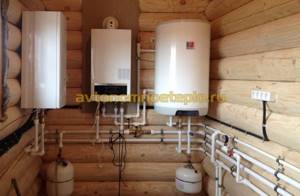
Connecting heating to a boiler that runs on gas
Connection diagram for a double-circuit boiler with a storage tank/water heater.
The location of the pipes may vary. This will depend on the manufacturers and models.
If the heating system has already been used before, and at the moment only the boiler will be replaced. You will need to drain the coolant from the system and be sure to flush it several times. A large number of different salts settle on the walls of radiators and pipes, which is why it is necessary to flush the system.
Both antifreeze and water can circulate in the heating system. You should definitely read in the technical documentation whether antifreeze can be used in the selected model.
It makes sense to use antifreeze as a coolant in the heating system when the boiler is turned on only periodically. In this case, the water in the pipes may freeze, but the antifreeze may not. However, if the user is in the house all the time and the boiler does not turn off during frosts, then water can be used as a coolant.
- Circulation pump (if needed).
- Ball valve.
- Coarse filter.
- Ball valve.
- American connection.
The circulation pump must always be stopped on the return line. Ball valves are needed to easily disconnect the system without draining the coolant and quickly remove the filter for cleaning and maintenance. A coarse filter in the heating system is needed to protect the heat exchanger from clogging with salts. It should be placed directly in front of the boiler, preferably on a horizontal section with the catcher facing down.
Connection diagram for DHW to a gas dual-circuit device:
- Coarse water filter.
- Ball valve.
- Magnetic filter or fine filter.
- Ball valve.
- American connection.
To maximize the service life of the additional heat exchanger of a 2-circuit boiler and ensure its protection against scale, a magnetic filter and coarse cleaning must be installed on the cold water supply pipe. If the last filter has already been installed previously, then it is not necessary to install it in front of the boiler.
All connections will need to be sealed with tow, special plumbing paste or FUM tape.
Liability for non-compliance
Of course, as in the case of any other violation of approved norms and rules, if the required distances from the gas pipe to the laid electrical cable are not observed, liability is provided for citizens.
Code of Administrative Offenses of the Russian Federation Article 9.4 promises the imposition of fines on violators. Well, and of course, for a dangerous connection, various regulatory documents practically ensure disconnection from the line if the faults are not eliminated.
By the way, monetary penalties are not that significant, even for repeated violations.
And, on the one hand, the contractor will still bear the punishment, and this, by all rights, is an organization that has access and licenses for laying gas and electrical networks. And they will not initially take risks if a responsible organization with operational experience is chosen.
But, as practice shows, most consumers use the services of private electricians without proper documentation and contracts, or do the wiring themselves.
And this is already Art. 7.19 of the Code of Administrative Offenses of the Russian Federation - unauthorized connection, for which you also face a fine. Well, and of course, in the event of unintentional harm to the health and damage to the property of other citizens as a result of illegal activities, the punishment will be even more severe - up to and including imprisonment.

P 88 RF PP N 410 dated 05/14/2013 states that all manipulations with gas equipment, including connecting the stove, can only be carried out by organizations that have the appropriate approval and license for such types of work
It is very difficult to clearly answer the question of what awaits you if the required distances are not observed. This is all at the discretion of higher authorities and officials.
Conclusions and useful video on the topic
What are electric ignition and gas control, is it necessary to combine gas and electricity:
Thus, the PUE and SP, which normalize the distance to the gas pipeline, are clearly stated and do not allow contradictions in practice. However, the fact is that all these rules were not developed in order to complicate your life, but to save it, as well as your property, life, health and belongings of other people living with you or nearby.
Did you comply with the standards when designing gas and electricity supply equipment in your home or apartment? Share your experience with us in the comments, and also ask questions about the topic of the article.
